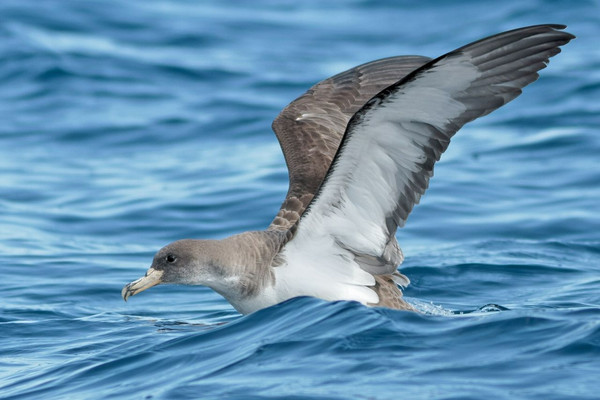Sperm Whales, The Azores, Portugal
The Best of Portugal’s Wildlife
 By Dominic Couzens
By Dominic Couzens19th April 2021
Dominic is a Naturetrek tour leader and one of Britain's
best known and most prolific natural history writers.
Nowadays it retains a cultural identity quite different to Spain, not least its own language, and visitors quickly appreciate the distinction.
As far as natural history is concerned, Portugal offers the twin treasures of a south coast and a western one, each with their own specialities. In Portugal’s hinterland the rolling hills of the Algarve give way to the plains of Alentejo to the north and eventually to higher mountains bisected by deep valleys and gorges; here are some of the quiet places of Europe, overlooked by everything except wildlife. Continental Portugal, however, is far from the full story. Two marvellous archipelagos in the Atlantic Ocean, Madeira and the Azores, offer something that is rare in the rest of Europe – a fauna and flora rich in endemic species. Both sites are also superb for seabirds and cetaceans.
Most visitors, whether conventional tourists or wildlife enthusiasts, find their way to Portugal’s playground, the Algarve. Many never make it further than the beaches, high-rises and shopping centres of this sunlit south coast, but beyond the hustle and bustle there are some superb places for enjoying what is effectively a Mediterranean fauna and flora, albeit west of Gibraltar. The flowers, birds, butterflies and herps (amphibians and reptiles) are all characteristic of this region, so even in the gardens of holiday villas there are Sardinian Warblers, Hoopoes, Iberian Green Lizards, Monarchs and Two-tailed Pashas. In the smallest, scruffiest clumps of garrigue vegetation, determined orchids flower, from early in the year.
The Algarve is blessed with some superb coastal nature reserves, particularly around the Ria Formosa Natural Park, Castro Marim and Quinta do Lago. The saltpans, marshes, Cork Oak woodlands and scrub hold a superb variety of birds all year round, including specialities such as Greater Flamingo and Purple Swamphen. In spring the wetlands teem with migrants, including a fine selection of waders, as well as herons such as Squacco and Purple, Collared Pratincoles and terns including Caspian and Little. It is a good spot for rarities, too. These add to the White Storks, Zitting Cisticolas, Kentish Plovers and Black-winged Stilts that are here all year round. Indeed, this is a fine autumn and winter destination, too, with birds such as Red-crested Pochards, Black-necked Grebes and Black-tailed Godwits in much higher numbers. There is a build-up of wildfowl and gulls such as Audouin’s and Slender-billed. The wetlands of the Algarve are, perhaps surprisingly, on a level with many of the best in southern Europe.

To the west, the scenery could hardly be more different. The flat coastline is replaced by the rocky coast and towering cliffs of Sagres and the Cape St. Vincent area, which is the extreme south-western tip of the European continent. This wind-blasted coastline is dominated by low garrigue, which harbours a number of rare flowers, including a few endemics. In early spring there is a fine display of orchids and daffodils in this area. The birds include Thekla Lark, Red-billed Chough, Spectacled Warbler, Blue Rockthrush and even a few Little Bustards.
It is, though, the sea that dominates. Cape St. Vincent is a reasonable place to spot Common and Bottlenose Dolphins and seabirds such as Cory’s Shearwater, and a boat trip greatly increases the chance of finding rarer species such as Wilson’s Petrel and Balearic Shearwater.

Just inland from the coast, the rolling hills of the Algarve, delightful in their own right, and with woodland species such as Golden Oriole and Western Bonelli’s Warbler, give way to the plains of the southern Alentejo. Although only a short drive away, this is a different world: very open, with patches of Cork Oaks and olive groves, and with long vistas. Around the famous area of Castro Verde, exciting birds such as Great Bustards and Black-bellied Sandgrouse can be found relatively easily, while you are serenaded by the constant exultant songs of Calandra Larks and the stop-start efforts of Short-toed Larks. The woodlands attract Azure-winged Magpies and Black-shouldered Kites, while the whole area is magnificent for big raptors such as Cinereous Vulture and Spanish Imperial Eagle.
Alentejo is one of Europe’s truly undisturbed regions. Air pollution is so low that the night skies here are famous for their remarkable clarity and consistency, and a visit to the Alqueva Dark Sky Reserve adds a welcome and unusual bonus to the area. In fact, you can marvel at constellations and galaxies by night, while enjoying flocks of Cranes, Sandgrouse and bustards by day, here in the region of Terena, just a day’s drive from Portugal’s bustling capital, Lisbon.
Indeed, Lisbon is by no means a poor area for wildlife. The nearby Tagus Estuary is internationally renowned – amazingly it hosts 120,000 birds in the winter, including species such as Greater Flamingoes, Avocets and phenomenal numbers of gulls and waders. This is also a good area for something of an ornithological quirk: the wetlands are home to a strange assortment of introduced species which are hard to see elsewhere in Europe, including Common Waxbill, Black-headed Weaver and Yellow-crowned Bishop.
An hour north from Lisbon is an area of coastline that is well known to locals but is refreshingly quiet as a tourist destination. The so-called ‘Silver Coast’ has miles of sandy beaches and sheltered rocky coves, and these are either lapped or pounded by the Atlantic Ocean, depending on the mood that it is in. The area is intriguingly good for wildlife, with a rich assortment of flowers, reptiles and butterflies. The Berlengas Islands, just offshore, are a breeding ground for Madeiran Storm-Petrels and Cory’s Shearwaters and also have some endemic plants. It is a good spot for the extremely localised and endangered Carbonell's Wall Lizard. There are excellent limestone ridges just inland with a marvellous flora, which attracts multiple pollinators, including butterflies. There is even a small area of coastal lagoons nearby with a range of waterbirds, including Greater Flamingoes.
What you might not expect, in Portugal, is a palaeontological marvel, but just inland is the National Monument of Dinosaur Footprints, where you can see a large number of Sauropod footprints. True, you are 175 million years too late to see the real thing, but they are extremely impressive, nonetheless.
Another tranquil corner of Portugal lies to the east of its second city, Porto, and close to the Spanish border. Not many tourists visit here, either, and it is so quiet that Wolves are making a comeback and other mammals, such as Otters and even Genet, can occasionally be seen. Close to the village of Castelo Rodrigo is a delicious area of gorges, woods and plains, which holds a suite of classic Iberian birds such as Black-eared Wheatear, Bee-eater, Southern Grey Shrike and Red-necked Nightjar. Nearby, a small part of the Rewilding Europe scheme provides a feeding station for Egyptian and Griffon Vultures, as well as affording sightings of Bonelli’s, Golden, Booted and Short-toed Eagles. The Serra da Estrela Natural Park to the south contains the highest peaks in mainland Portugal. This wild, rugged area is superb for wildflowers, including a number of poorly known endemics, and the endemic Guadarrama Wall Lizard also occurs here.

There is another prehistoric quirk in this part of Portugal. In the Côa Valley, readily accessible and best viewed after dark, is Europe’s best collection of Palaeolithic rock engravings, which date back to 22,000 BC. In the dark you can almost imagine being back in the time when Tarpans (wild horses) and Auroxen (wild cattle) grazed hereabouts. The deer depicted still occur in this area. Iberian Hares are also sometimes seen in the valley.
The archipelagos of Portugal, Madeira and the Azores, are both a considerable distance from the Portuguese mainland. Madeira lies to the south-west, 550km off the coast of North Africa, while the Azores are right out on the Mid-Atlantic Ridge. Both are small and contained worlds of their own.
Madeira is a small collection of five main islands, the largest of which, eponymously called Madeira, is about the size of the Isle of Wight, but spectacularly mountainous, and rising to 1,830m. There are numerous volcanic ridges, valleys and slopes, all of which, on this isolated island, host a spectacular flora. Madeira is sometimes known as the ‘Floating Garden’, not only for the 1,163 plant species that grow here, but also for the local habit of growing flowers seemingly everywhere. In June and July, it can seem like a very large nursery! Of the wild plant species, a phenomenal total of 113 are endemic, such as Madeiran Yellow Violet, Madeiran Barberry, Madeiran Foxglove and Madeiran Heather. One of the delights of a visit here is that you can follow along the levadas – man-made watercourses that traverse much of the island. There are also a couple of endemic landbirds: the local Madeiran Firecrest, and the Trocaz Pigeon, which is confined to upland Laurissilva forest.

Around the seas of Madeira, however, there is an exceptional assemblage of seabirds, some of which are very rare. The Desertas Islands, just 25km south-east of Madeira Island, must be one of the most exciting places for any seabird enthusiast to go in the western Atlantic. Naturetrek offers a short cruise in the breeding season, with an overnight stay on Deserta Grande, providing the opportunity to see Cory’s and Manx Shearwaters, Madeiran Storm-Petrel, Bulwer’s Petrel and both Desertas and Zino’s Petrels!
Not surprisingly, these waters are also excellent for cetaceans, although Madeira is still a new and undiscovered destination for sea mammals. About 20 species have been recorded. Even on short cruises out of Funchal, the capital, it is possible to catch sight of Short-finned Pilot Whale, Atlantic Spotted, Risso’s and Bottlenose Dolphins and sometimes Sperm Whale.
Further out into the Atlantic, some 1,400km west of Lisbon and about 2,000km from Canada, the Azores are already firmly established as a world-class whale and dolphin-watching destination. The area around the three main central islands, Faial, Pico and São Jorge, is home to a resident population of Sperm Whales. The animals are used to fast-moving inflatable Zodiacs, and on the morning or afternoon whale-watching trips, the animals often come so close, of their own accord, that you can almost feel their blows. In summer, the area is also great for a variety of dolphins and is noted for Beaked Whales. The Azores have a wonderful, lush atmosphere and the volcanic slopes are overrun with colourful hydrangeas. The vista of the central archipelago is dominated by the impressive volcanic peak of Pico, which rises to 2,351m. Ironically, far out in the middle of the Atlantic, it is Portugal’s highest peak.

In spring, there is potential extra spice to an Azorean cetacean holiday. It has recently been discovered that some of the great whales pass by the archipelago on their way between their southern breeding grounds and their foraging grounds around eastern Greenland and Iceland – a mid-Atlantic stopover very different to the usual human one. Fin Whales, Sei Whales, Minke Whales and even Blue Whales are all possible. The animals can be found not only around the central group of islands, but also from São Miguel, the largest of the islands, home of its not very bustling capital Ponta Delgada. Visitors on this tour can also catch up with the endangered endemic Azores Bullfinch.
Watching whales in the deep waters of the mid-Atlantic is a thrill, of course, and about as far as you can come from watching a Hoopoe feeding on the lawn of your villa in the Algarve. Portugal, indeed, is full of surprises.

Spring in Southern Portugal




 Loading search...
Loading search...
